MedievalReporter.com
Covering history's most marvelous millennium
Join our newsletter!

Covering history's most marvelous millennium
Covering history's most marvelous millennium

Three generations of Crusader kings had to deal with princess and queen Melisende of Jerusalem. None of them were able to exclude her from the government of the kingdom. How was she able to circumvent medieval gender norms and amass tremendous power in the so-called Kingdom of Heaven?
Grab a short intro to the Crusades from our Medieval Guidebook.
The Kingdom of Jerusalem was the most powerful Crusader state in the Holy Land after the First Crusade. Melisende’s father, Baldwin, had traveled east with this campaign. Through scheming and conniving, he ended up on the throne of the kingdom as Baldwin II in 1118 CE.
Melisende was 13 years old at the time. She changed from eldest daughter of a nobleman to heir of the Kingdom of Jerusalem overnight.
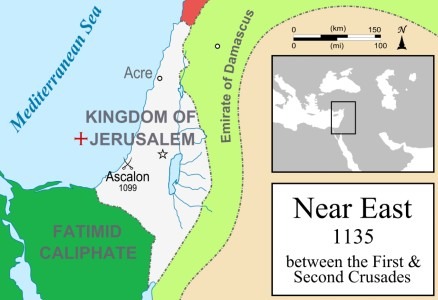
Baldwin II’s ascension to the throne, however, had been little short of a coup. Keenly aware of the illegality of his family’s hold on power, he tried to strengthen and legitimize his eldest daughter’s position. Melisende needed to be able to take over, should her father die an early death.
Therefore, the king involved her with political decision-making while she was still young. Melisende’s name appeared in official diplomatic correspondence while her father still reigned. And coins were minted in her image while she was still a princess.
Fortunately for Baldwin, the princess turned out to be an intelligent and charming woman. The royal council, an important political body in the kingdom, grew fond of her company. Before long, Melisende could count on the support of the court without the help of her father.
She would need much of it later in life.

– advertisement –
– article continues below –
Despite Melisende’s qualities, a 12th-century woman was still a woman. Medieval customs did not normally allow for queens to rule in their own right. Eldest daughter to the king or no, Melisende was heir presumptive.
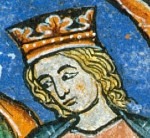
In her day and age, this meant that she was the official successor to king Baldwin II. But, she would be forced to marry and share power with her would-be husband. She would become queen consort to him – rather than queen regnant, ruling in her own right.
A suitable marriage candidate was found in the ambitious Fulk of Anjou. In 1129 CE, he and Melisende married. Fulk would become the next King of Jerusalem.
Two years later, the old king – Baldwin II – died. Melisende and Fulk faced a challenging relationship test: they ascended to the throne of Jerusalem as queen consort and king. The marriage soon turned sour.
King Fulk started to look for ways to sideline his queen. Melisende had received a thorough political education from her father, however. She was not one to be easily discarded.
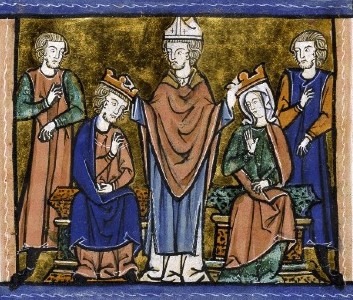
Before long, queen Melisende was excluded from official decision-making by her newly crowned husband. This irritated many members of the royal council, where she enjoyed a lot of support. Fulk also tried to dominate the realm and did not consult his advisors much, further annoying the council.
Upping his game, Fulk soon accused Melisende of having an affair with one of the most important nobles of the kingdom. The king managed to have the noble exiled. Apparently, this was not enough: an assassination attempt on the noble’s life followed.

The plot failed. However, for the queen matters had gone far enough. Though evidence never substantiated, Melisende directly accused Fulk of orchestrating the assassination.
Now Fulk’s autocratic style of government came back to haunt him. As the royal council sided with Melisende, his influence collapsed like a house of cards. The queen’s party took control of the kingdom.
Melisende became the most powerful person in the realm, wielding more influence than many queen consorts ever possessed. The queen had turned the king into a mere pawn.
Her marriage with Fulk was eventually reconciled. But the king never regained his influence at court. Melisende’s victory was complete – for now.
“[Fulk] never attempted to take the initiative, even in trivial matters, without [Melisende’s] consent.”
— Contemporary historian William of Tyre on the outcome of the fight between Melisende and Fulk
Living out his later years in the political shadows, king Fulk died in 1143 CE in a hunting accident. Fulk and Melisende’s son, prince Baldwin III, was only thirteen years old at the time. Though he was crowned as king that year, his mother completely overshadowed him.

At first, Baldwin III displayed little appetite for politics. But as the muslim threat in the region loomed ever greater, Melisende called for help from the West – sparking the Second Crusade. The military developments that followed sucked young Baldwin into the affairs of the Near East.
It soon became clear that wise Melisende had given birth to a competent commander. Dealing with Jerusalem’s enemies on the battlefield seemed to bring out the best in him. With growing self-confidence, the young king started to assert himself and came into conflict with his mother.
Well aware that her late husband’s tyrannical tendencies had contributed to his downfall, Melisende put the matter to the royal council. As much as the courtiers liked their queen, they couldn’t ignore young Baldwin’s claim to power. The council decided to split the kingdom between mother and son.
As usual, Melisende was aware of the bigger picture. The Second Crusade had failed to achieve tangible gains in the area. With the muslims applying an ever tighter chokehold on the kingdom, the queen was worried that a division of resources might spell the end.
In the event, the threat came from within: Baldwin declared war on his mother.
Baldwin felt cheated because the royal council had awarded Melisende the greater part of the kingdom. By now, the queen was universally recognized as an exceptionally wise ruler. The court had not been ready to transfer power to her son just yet and gave Baldwin III just a slice.
Queen Melisende was many things, but – as a medieval woman – she had not been able to garner a lot of military experience. War, even more so than politics, was a men’s world. In this arena only, Baldwin III held better cards than his mother.
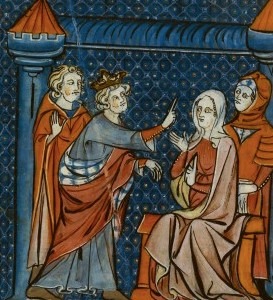
He plunged the Kingdom of Jerusalem into civil war. In the field, the young king quickly overcame the forces of his regent, the queen. Within a couple of weeks, he had invaded and subdued most of Melisende’s part of the realm.
As a testament to her popularity, the Church – not usually at the forefront when defending a woman’s honor – mediated on Melisende’s behalf. Mother and son struck a peace deal that allowed the queen to remain at court. In an era when women that failed in politics were often banned to a convent, this was still a great achievement for Melisende.
Baldwin III had militarily subjugated his own kingdom, but he had not won the hearts and minds of his people. The royal council still loved Melisende and refused to fully cooperate with the king. Fearing to end up like his late despotic father Fulk, Baldwin installed a chief advisor to bridge the gap.
This advisor – you guessed it – was his mother.
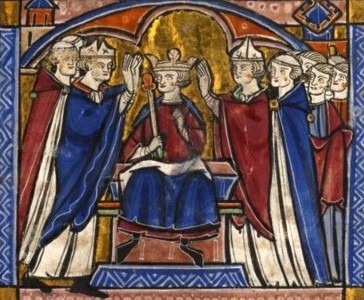
– advertisement –
– article continues below –
In the middle of the Middle Ages, it was not easy for a woman to take the reins of a kingdom – let alone one so threatened by its muslim neighbors as Jerusalem.
Queen Melisende, however, did precisely that. Through palace intrigue, she completely sidelined her ambitious husband, king Fulk. And though she lost in the field against her son, young Baldwin III could not rule the realm without reinstalling her in a position of great prestige and influence.
Melisende truly earned the epitaph “the Magnificent”.
“She was a very wise woman, fully experienced in almost all affairs of state business, who completely triumphed (…) so that she could take charge of important affairs. [S]triving to emulate the glory of the best princes, Melisende ruled the kingdom with such ability that she was rightly considered to have equaled her predecessors in that regard.”
— William of Tyre on the legacy of Melisende’s 30-year reign
Disclosure: we work hard to provide you with exclusive medieval reports and guides. To make the Middle Ages accessible to everybody, we’d like this information to remain FREE. Therefore, some of the links below are affiliate links, meaning – at no additional cost to you – we will earn a small compensation if you click through.
Comments are closed.
Very good information. Lucky me I found your website by chance (stumbleupon).
I’ve book marked it for later!
Glad you liked it, Olive. We’re lucky that you found us, too. Thanks for bookmarking us!
Useful info. Fortunate me I discovered your site accidentally, and I’m stunned
why this accident did not happened earlier! I bookmarked it.
Thanks for stopping by, Maddison. Welcome back anytime!
Good day! I know this is somewhat off topic but I was
wondering which blog platform are you using for this site?
I’m getting sick and tired of WordPress because I’ve had issues with hackers and I’m looking at
options for another platform. I would be fantastic if
you could point me in the direction of a good platform.
Hello, Rich! We hate to tell you, but WordPress is exactly what we’re using. However, issues with hackers sounds like nothing to sneeze at. Perhaps you could post your question on something like Reddit? There are probably tons of knowledgeable people on there that would be willing to help you out. Good luck!
You actually make it seem so easy with your presentation but I
find this topic to be really something which I think I would never understand.
It seems too complex and extremely broad for me. I’m looking
forward for your next post, I’ll try to get the hang of it!
That’s all right, Edith! The Middle Ages can be a daunting subject to study. But that’s also what makes them extremely interesting. Here, at Medieval Reporter, we strive to break them in complexity so that the “uninitiated” can enjoy their intricacies as well.
That’s why we’re also building our Medieval Guidebook. It can help you get started. For example, have you taken a look at our Beginner’s Guide? Link: https://medievalreporter.com/guidebook/beginners-guide-middle-ages/
Please let us know if there’s a specific subject we could clarify for you!
Very great post. I simply stumbled upon your blog and wished to mention that I have truly loved browsing your blog posts.
I hope you
write again soon!
Thanks so much, Irene! Out of curiosity, how did you find us?
We’ll keep throwing reports your way – don’t you worry about that. 😉